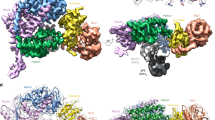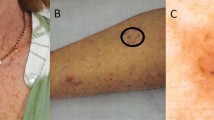Abstract
The variant form of the human syndrome xeroderma pigmentosum (XPV) is caused by a deficiency in DNA polymerase η (Polη), a DNA polymerase that enables replication through ultraviolet-induced pyrimidine dimers. Here we report high-resolution crystal structures of human Polη at four consecutive steps during DNA synthesis through cis-syn cyclobutane thymine dimers. Polη acts like a ‘molecular splint’ to stabilize damaged DNA in a normal B-form conformation. An enlarged active site accommodates the thymine dimer with excellent stereochemistry for two-metal ion catalysis. Two residues conserved among Polη orthologues form specific hydrogen bonds with the lesion and the incoming nucleotide to assist translesion synthesis. On the basis of the structures, eight Polη missense mutations causing XPV can be rationalized as undermining the molecular splint or perturbing the active-site alignment. The structures also provide an insight into the role of Polη in replicating through D loop and DNA fragile sites.
This is a preview of subscription content, access via your institution
Access options
Subscribe to this journal
Receive 51 print issues and online access
$199.00 per year
only $3.90 per issue
Buy this article
- Purchase on Springer Link
- Instant access to full article PDF
Prices may be subject to local taxes which are calculated during checkout





Similar content being viewed by others
Accession codes
References
Brash, D. E. Sunlight and the onset of skin cancer. Trends Genet. 13, 410–414 (1997)
Masutani, C. et al. The XPV (xeroderma pigmentosum variant) gene encodes human DNA polymerase η. Nature 399, 700–704 (1999)
Johnson, R. E., Kondratick, C. M., Prakash, S. & Prakash, L. hRAD30 mutations in the variant form of xeroderma pigmentosum. Science 285, 263–265 (1999)
Hishida, T., Kubota, Y., Carr, A. M. & Iwasaki, H. RAD6–RAD18–RAD5-pathway-dependent tolerance to chronic low-dose ultraviolet light. Nature 457, 612–615 (2009)
Chaney, S. G., Campbell, S. L., Bassett, E. & Wu, Y. Recognition and processing of cisplatin- and oxaliplatin-DNA adducts. Crit. Rev. Oncol. Hematol. 53, 3–11 (2005)
Saribasak, H., Rajagopal, D., Maul, R. W. & Gearhart, P. J. Hijacked DNA repair proteins and unchained DNA polymerases. Phil. Trans. R. Soc. Lond. B 364, 605–611 (2009)
Kawamoto, T. et al. Dual roles for DNA polymerase η in homologous DNA recombination and translesion DNA synthesis. Mol. Cell 20, 793–799 (2005)
McIlwraith, M. J. et al. Human DNA polymerase η promotes DNA synthesis from strand invasion intermediates of homologous recombination. Mol. Cell 20, 783–792 (2005)
Bugreev, D. V., Hanaoka, F. & Mazin, A. V. Rad54 dissociates homologous recombination intermediates by branch migration. Nature Struct. Mol. Biol. 14, 746–753 (2007)
Rey, L. et al. Human DNA polymerase η is required for common fragile site stability during unperturbed DNA replication. Mol. Cell. Biol. 29, 3344–3354 (2009)
Broughton, B. C. et al. Molecular analysis of mutations in DNA polymerase η in xeroderma pigmentosum-variant patients. Proc. Natl Acad. Sci. USA 99, 815–820 (2002)
Tanioka, M. et al. Molecular analysis of DNA polymerase η gene in Japanese patients diagnosed as xeroderma pigmentosum variant type. J. Invest. Dermatol. 127, 1745–1751 (2007)
Inui, H. et al. Xeroderma pigmentosum-variant patients from America, Europe, and Asia. J. Invest. Dermatol. 128, 2055–2068 (2008)
Kusumoto, R., Masutani, C., Shimmyo, S., Iwai, S. & Hanaoka, F. DNA binding properties of human DNA polymerase η: implications for fidelity and polymerase switching of translesion synthesis. Genes Cells 9, 1139–1150 (2004)
McCulloch, S. D. et al. Preferential cis-syn thymine dimer bypass by DNA polymerase η occurs with biased fidelity. Nature 428, 97–100 (2004)
Yao, J., Dixon, K. & Carty, M. P. A single (6–4) photoproduct inhibits plasmid DNA replication in xeroderma pigmentosum variant cell extracts. Environ. Mol. Mutagen. 38, 19–29 (2001)
Scrima, A. et al. Structural basis of UV DNA-damage recognition by the DDB1–DDB2 complex. Cell 135, 1213–1223 (2008)
Sugasawa, K. XPC: its product and biological roles. Adv. Exp. Med. Biol. 637, 47–56 (2008)
Yang, W. & Woodgate, R. What a difference a decade makes: insights into translesion DNA synthesis. Proc. Natl Acad. Sci. USA 104, 15591–15598 (2007)
Broyde, S., Wang, L., Rechkoblit, O., Geacintov, N. E. & Patel, D. J. Lesion processing: high-fidelity versus lesion-bypass DNA polymerases. Trends Biochem. Sci. 33, 209–219 (2008)
Trincao, J. et al. Structure of the catalytic core of S. cerevisiae DNA polymerase η: implications for translesion DNA synthesis. Mol. Cell 8, 417–426 (2001)
Alt, A. et al. Bypass of DNA lesions generated during anticancer treatment with cisplatin by DNA polymerase η. Science 318, 967–970 (2007)
Wang, L., Broyde, S. & Zhang, Y. Polymerase-tailored variations in the water-mediated and substrate-assisted mechanism for nucleotidyl transfer: insights from a study of T7 DNA polymerase. J. Mol. Biol. 389, 787–796 (2009)
Ling, H., Boudsocq, F., Woodgate, R. & Yang, W. Crystal structure of a Y-family DNA polymerase in action: a mechanism for error-prone and lesion-bypass replication. Cell 107, 91–102 (2001)
Glick, E., Vigna, K. L. & Loeb, L. A. Mutations in human DNA polymerase η motif II alter bypass of DNA lesions. EMBO J. 20, 7303–7312 (2001)
Li, Y. et al. Nucleotide insertion opposite a cis-syn thymine dimer by a replicative DNA polymerase from bacteriophage T7. Nature Struct. Mol. Biol. 11, 784–790 (2004)
Ling, H., Boudsocq, F., Plosky, B. S., Woodgate, R. & Yang, W. Replication of a cis–syn thymine dimer at atomic resolution. Nature 424, 1083–1087 (2003)
Park, H. et al. Crystal structure of a DNA decamer containing a cis-syn thymine dimer. Proc. Natl Acad. Sci. USA 99, 15965–15970 (2002)
Vassylyev, D. G. et al. Atomic model of a pyrimidine dimer excision repair enzyme complexed with a DNA substrate: structural basis for damaged DNA recognition. Cell 83, 773–782 (1995)
Min, J. H. & Pavletich, N. P. Recognition of DNA damage by the Rad4 nucleotide excision repair protein. Nature 449, 570–575 (2007)
Mees, A. et al. Crystal structure of a photolyase bound to a CPD-like DNA lesion after in situ repair. Science 306, 1789–1793 (2004)
Yang, W. Poor base stacking at DNA lesions may initiate recognition by many repair proteins. DNA Repair (Amst.) 5, 654–666 (2006)
Lone, S. et al. Human DNA polymerase κ encircles DNA: implications for mismatch extension and lesion bypass. Mol. Cell 25, 601–614 (2007)
Bauer, J. et al. A structural gap in Dpo4 supports mutagenic bypass of a major benzo[α]pyrene dG adduct in DNA through template misalignment. Proc. Natl Acad. Sci. USA 104, 14905–14910 (2007)
Jia, L., Geacintov, N. E. & Broyde, S. The N-clasp of human DNA polymerase κ promotes blockage or error-free bypass of adenine- or guanine-benzo[α]pyrenyl lesions. Nucleic Acids Res. 36, 6571–6584 (2008)
Ling, H., Boudsocq, F., Woodgate, R. & Yang, W. Snapshots of replication through an abasic lesion; structural basis for base substitutions and frameshifts. Mol. Cell 13, 751–762 (2004)
Wilson, R. C. & Pata, J. D. Structural insights into the generation of single-base deletions by the Y family DNA polymerase dbh. Mol. Cell 29, 767–779 (2008)
Jarosz, D. F., Godoy, V. G., Delaney, J. C., Essigmann, J. M. & Walker, G. C. A single amino acid governs enhanced activity of DinB DNA polymerases on damaged templates. Nature 439, 225–228 (2006)
Lehmann, A. R. et al. Translesion synthesis: Y-family polymerases and the polymerase switch. DNA Repair (Amst.) 6, 891–899 (2007)
Di Lucca, J. et al. Variants of the xeroderma pigmentosum variant gene (POLH) are associated with melanoma risk. Eur. J. Cancer 45, 3228–3236 (2009)
Bassett, E. et al. Efficiency of extension of mismatched primer termini across from cisplatin and oxaliplatin adducts by human DNA polymerases β and η in vitro. Biochemistry 42, 14197–14206 (2003)
Kokoska, R. J., McCulloch, S. D. & Kunkel, T. A. The efficiency and specificity of apurinic/apyrimidinic site bypass by human DNA polymerase η and Sulfolobus solfataricus Dpo4. J. Biol. Chem. 278, 50537–50545 (2003)
Kusumoto, R., Masutani, C., Iwai, S. & Hanaoka, F. Translesion synthesis by human DNA polymerase η across thymine glycol lesions. Biochemistry 41, 6090–6099 (2002)
Masutani, C., Kusumoto, R., Iwai, S. & Hanaoka, F. Mechanisms of accurate translesion synthesis by human DNA polymerase η. EMBO J. 19, 3100–3109 (2000)
Wang, F. & Yang, W. Structural insight into translesion synthesis by DNA Pol II. Cell 139, 1279–1289 (2009)
McCoy, A. J. Solving structures of protein complexes by molecular replacement with Phaser. Acta Crystallogr. D 63, 32–41 (2007)
Hendrickson, W. A., Horton, J. R. & LeMaster, D. M. Selenomethionyl proteins produced for analysis by multiwavelength anomalous diffraction (MAD): a vehicle for direct determination of three-dimensional structure. EMBO J. 9, 1665–1672 (1990)
Brünger, A. T. et al. Crystallography and NMR system: a new software suite for macromolecular structure determination. Acta Crystallogr. D 54, 905–921 (1998)
Emsley, P., Lohkamp, B., Scott, W. G. & Cowtan, K. Features and development of Coot. Acta Crystallogr. D 66, 486–501 (2010)
Otwinowski, Z. & Minor, W. Processing of X-ray diffraction data collected in oscillation mode. Methods Enzymol. 276, 307–326 (1997)
Kabsch, W. XDS. Acta Crystallogr. D 66, 125–132 (2010)
CCP4. The CCP4 suite: programs for protein crystallography. Acta Crystallogr. D 50, 760–763 (1994)
McCoy, A. J. et al. Phaser crystallographic software. J. Appl. Crystallogr. 40, 658–674 (2007)
Terwilliger, T. C. & Berendzen, J. Automated structure solution for MIR and MAD. Acta Crystallogr. D 55, 849–861 (1999)
Vonrhein, C., Blanc, E., Roversi, P. & Bricogne, G. Automated structure solution with autoSHARP. Methods Mol. Biol. 364, 215–230 (2007)
Davis, I. W. et al. MolProbity: all-atom contacts and structure validation for proteins and nucleic acids. Nucleic Acids Res. 35, W375–W383 (2007)
Nicholls, A., Sharp, K. A. & Honig, B. Protein folding and association: insights from the interfacial and themodynamic properties of hydrocarbons. Proteins 11, 281–296 (1991)
Creighton, S., Bloom, L. B. & Goodman, M. F. Gel fidelity assay measuring nucleotide misinsertion, exonucleolytic proofreading, and lesion bypass efficiencies. Methods Enzymol. 262, 232–256 (1995)
Acknowledgements
We thank D. Leahy, M. Gellert and R. Craigie for critical reading of the manuscript. The research was funded by the intramural research program of NIDDK, NIH, and grants from the Ministry of Education, Culture, Sports, Science, and Technology of Japan. Y.Z. is the recipient of a Chinese Ministry of Education scholarship and joint PhD student in NIH-Zhejiang University Graduate Partnership Program. S.R.-M. received a fellowship from the Human Frontiers Science Program.
Author information
Authors and Affiliations
Contributions
C.B. determined the five structures; Y.Z. prepared the samples and grew the crystals; Y.K. did the kinetic and bypass assays; S.R.-M. determined the type 1 structure; M.G. prepared the clone and type 1 crystals; J.Y.L. made mutants; C.M. designed the functional assays; A.R.L. identified the unpublished XPV mutations; F.H. conceived the project; and W.Y. supervised the structure determination. C.B., Y.Z., F.H. and W.Y. prepared the manuscript. C.B. and Y.Z. contributed equally to the study. All authors discussed the results and commented on the manuscript.
Corresponding authors
Ethics declarations
Competing interests
The authors declare no competing financial interests.
Supplementary information
Supplementary Information
This file contains Supplementary Figures 1-9 with legends and Supplementary Tables 1-3 (PDF 4336 kb)
Rights and permissions
About this article
Cite this article
Biertümpfel, C., Zhao, Y., Kondo, Y. et al. Structure and mechanism of human DNA polymerase η. Nature 465, 1044–1048 (2010). https://doi.org/10.1038/nature09196
Received:
Accepted:
Issue Date:
DOI: https://doi.org/10.1038/nature09196
This article is cited by
-
Homozygous substitution of threonine 191 by proline in polymerase η causes Xeroderma pigmentosum variant
Scientific Reports (2024)
-
Genetic and physical interactions between Polη and Rev1 in response to UV-induced DNA damage in mammalian cells
Scientific Reports (2021)
-
Mechanism of genome instability mediated by human DNA polymerase mu misincorporation
Nature Communications (2021)
-
Characterization of DNA polymerase δ from deep-sea hydrothermal vent shrimp Rimicaris exoculata
Acta Oceanologica Sinica (2021)
-
Large deletions in immunoglobulin genes are associated with a sustained absence of DNA Polymerase η
Scientific Reports (2020)
Comments
By submitting a comment you agree to abide by our Terms and Community Guidelines. If you find something abusive or that does not comply with our terms or guidelines please flag it as inappropriate.



